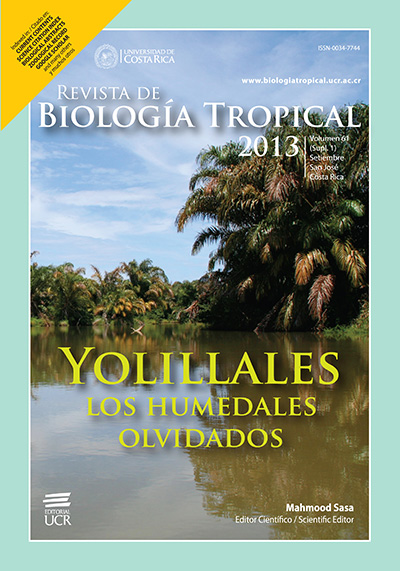Abstract
In Raffia (Raphia taedigera) palm-swamps, it is frequent to observe high mounds at the base of the palm clumps. These mounds are formed by the accumulation of litter and organic matter, or might result from upturned roots of wind-thrown trees. The mounds serve as anchorage site for the palms, and could be important for the establishment of woody tree species in the swamp. The formation of these mounds might be explained by the unequal accumulation of organic matter in the wetland, or by differences in decomposition rates between Raffia litter versus the litter produced in adjacent mixed forests. To distinguish between these hypotheses, I compared the spatial distribution of litter in a R. taedigera swamp with the litter distribution on an adjacent slope forest, where litter distribution is expected to be homogeneous. In addition, I compared decomposition rates of major components of fine litter in three different environments: two wetlands dominated by palms (R. taedigera and Manicaria saccifera) and a slope forest that experiences lower inundation effects. On the palm swamp, noticeable concentration of litter was observed near the bases of clumps of palm as opposed to the swamp floor. In the adjacent slope forest, the magnitude of the differences in the distribution of litter is small and there is no accumulation at the base of emergent trees. It was also found that litter production increases during heavy rains and storms that follow dry periods. The swamp environment, independent of the litter, showed significantly lower decomposition rates than the surrounding forest slope. Furthermore, R. taedigera litter decomposes as fast as the slope forest litter. Overall, these results suggest that resistance to decomposition is not a major factor in the formation of mounds at the bases of R. taedigera clumps. Instead, litter accumulation contributes to the formation of the mounds that rise above the surface of the swamp.
References
Beard, J.S. 1944. Climax vegetation in tropical America. Ecology 25: 127-158
Beard, J.S. 1955. The classification of tropical American vegetation-types. Ecology 36: 89-100.
Bernhard-Reversat, F. 1972. Décomposition de la litíere de feuilles en foret ombrophile de Basse, Cote d’ Ivoire. Oecologia Plantarum 7: 279-300.
Braun, A. 1968. Cultivated palms of Venezuela. Principes 12: 39-103.
Bray, J.R. & E. Gorham. 1964. Litter production in forests of the world, p. 101-157. In J.B. Cragg (ed.). Advances in ecological research, volume 2. Academic, Londres, Inglaterra.
Brown, S. 1980. Rates of organic matter accumulation and litter production in tropical forest ecosystems, p. 118-139. In S.A. Brown, A. Lugo & L. Liegel (eds.). The role of tropical forests on the world carbon cycle. U.S. Department of Energy, Washington, Columbia, EE.UU.
Connell, J.H. & R.O. Slatyer. 1977. Mechanisms of succession in natural communities and their role in community stability and organization. Am. Nat. 11: 1119-1144.
Edwards, P.J. 1977. Studies of mineral cycling in a montane rain forest in New Guinea. II. The production and disappearance of litter. J. Ecol. 65: 971-992.
Ewel, J.J. 1976. Litterfall and leaf decomposition in a tropical forest succession in eastern Guatemala. J. Ecol. 64: 293-308.
Fanshawe, D.B. 1954. Forest types of British Guiana. Carib. Forester 15: 73-111.
Fölster, H., G. de las Salas & P. Khanna. 1976. A tropical evergreen forest site with perched water table, Magdalena Valley, Colombia: Biomass and bioelement inventory of primary and secondary vegetation. Oecol. Plantarum 11: 297-320.
Hainess, B. & R.B. Foster. 1977. Energy flow through litter in a Panamanian forest. J. Ecol. 65: 147-155.
Hartshorn, G.S. 1978. Tree falls and tropical forest dynamics, p. 617-638. In P.B. Tomlinson & M.H. Zimmermann (eds.). Tropical trees as living Systems. Cambridge University, Nueva York, EE.UU.
Holdridge, L.R., W.C. Grenk, W.H. Hatheway, T. Liang & J.A. Tosi, Jr. 1971. Forest environments in tropical life zones: a pilot study. Pergamon, Oxford, Inglaterra.
Janzen, D.H. 1974. Tropical blackwater rivers, animals, and mast fruiting by the Dipterocarpaceae. Biotropica 6: 69-103.
Klinge, H. 1978. Litter production in tropical ecosystems. Malay. Nat. J. 30: 415-422.
Kunkel-Westphal, I. & P. Kunkel. 1979. Litterfall in a Guatemalan primary forest, with details of leafshedding by some common tree species. J. Ecol. 65: 665-686.
McCarty, J. 1962. The colonization of swamp forest clearing. East Afr. Agr. Forest J. 28: 22-28.
Monk, C.D. 1966. An ecological study of hardwood swaps in north-central Florida. Ecology 47: 649-654.
Mulholland, P. & E. Kuenzler. 1979. Organic carbon sport from upland and forested wetland watersheds. Limnol. Oceanogr. 24: 960-966.
Myers, R.L. 2013a. Germinación de semillas y supervivencia de plántulas en pantanos dominados por yolillo Raphia taedigera (Arecaceae) en las Llanuras de Tortuguero, Costa Rica. Rev. Biol. Trop. 61 (Supl. 1): 47-66.
Myers, R.L. 2013b. Fenología y crecimiento de Raphia taedigera (Aracaceae) en humedales del noreste de Costa Rica. Rev. Biol. Trop. 61 (Supl. 1): 35-45.
Myers, R.L. 2013c. Humedales dominados por palmas (Arecaceae) en el Neotrópico: Una introducción. Rev. Biol. Trop. 61 (Supl. 1): 5-24.
Nordlie, F.G. & D.P. Kelso. 1975. Trophic relationships in a tropical estuary. Rev. Biol. Trop. 23: 77-99.
Ponnamperuma, F.M. 1972. The chemistry of submerged soils. Adv. Agron. 24:29-96.
Taylor, B.W. 1959. The classification of the lowland swamp communities in northeastern Papua. Ecology 40: 703-711.
Wilberth, J. 1976. Manicaria saccifera and its cultural significance among the Warao Indians of Venezuela. Bot. Mus. Leaf. Harvard Univ. 24: 275-335.
##plugins.facebook.comentarios##

This work is licensed under a Creative Commons Attribution 4.0 International License.
Copyright (c) 2013 Revista de Biología Tropical






